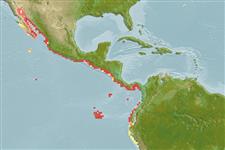Environment: milieu / climate zone / depth range / distribution range
Ekologi
laut berasosiasi dengan karang; kisaran kedalaman 10 - 60 m (Ref. 91172). Tropical; 33°N - 12°S, 115°W - 78°W (Ref. 55)
Eastern Pacific: Mexico to Peru.
Length at first maturity / Size / Weight / umur
Maturity: Lm 26.4, range 17 - 18 cm
Max length : 105 cm TL jantan/; (Ref. 106806); Berat maksimum terpublikasi: 1.3 kg (Ref. 40637)
deskripsi pendek
Kunci identifiaksi (pengenalan) | Morfologi | Morfometrik
Duri punggung (Keseluruhan (total)) : 10; duri punggung lunak (Keseluruhan (total)) : 12 - 13; Duri dubur: 3; Sirip dubur lunak: 8. Preopercular notch and knob weak. Scale rows on back rising obliquely above the lateral line. Pale crimson on side, often with silvery sheen of horizontal rows of bluish spots; belly golden yellow. Head with bluish spots and irregular broken lines, especially across cheek. A large blackish blotch on the upper back below the posterior of the dorsal spines.
Adults are found over hard bottoms in inshore reef areas. Generally solitary or in small groups but may occasionally form big schools (Ref. 9313). Juveniles inhabit estuaries and mouths of rivers (Ref. 9313). Carnivorous, feed on invertebrates and fish (Ref. 9313). Marketed fresh or frozen (Ref. 9313).
Allen, G.R., 1985. FAO Species Catalogue. Vol. 6. Snappers of the world. An annotated and illustrated catalogue of lutjanid species known to date. FAO Fish. Synop. 125(6):208 p. Rome: FAO. (Ref. 55)
Status IUCN Red List (Ref. 130435)
ancaman kepada manusia
Harmless
penggunaan manusia
Perikanan: komersial; Ikan buruan: ya
Alat, peralatan
laporan khas
muat turun XML
Sumber internet
Estimates based on models
Preferred temperature (Ref.
123201): 22.3 - 29.1, mean 26.2 °C (based on 214 cells).
Phylogenetic diversity index (Ref.
82804): PD
50 = 0.5000 [Uniqueness, from 0.5 = low to 2.0 = high].
Bayesian length-weight: a=0.01349 (0.00844 - 0.02157), b=2.91 (2.78 - 3.04), in cm total length, based on LWR estimates for this species & Genus-body shape (Ref.
93245).
Trophic level (Ref.
69278): 4.0 ±0.2 se; based on diet studies.
Daya lenting (Ref.
120179): sedang, Waktu penggandaan populasi minimum 1.4 - 4.4 tahun (K = 0.19; Fec = 66,400).
Prior r = 0.57, 95% CL = 0.37 - 0.85, Based on 1 data-limited stock assessment.
Fishing Vulnerability (Ref.
59153): Low to moderate vulnerability (35 of 100).
Nutrients (Ref.
124155): Calcium = 28.4 [17.6, 41.8] mg/100g; Iron = 0.327 [0.204, 0.502] mg/100g; Protein = 18.8 [17.3, 20.2] %; Omega3 = 0.127 [0.086, 0.183] g/100g; Selenium = 71.2 [46.4, 111.1] μg/100g; VitaminA = 88 [17, 326] μg/100g; Zinc = 0.362 [0.282, 0.513] mg/100g (wet weight);
